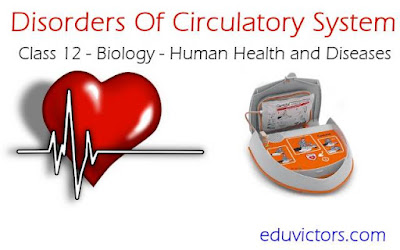DISORDERS OF THE CIRCULATORY SYSTEM
Biology - Human Health and Diseases
Following are the diseases that can affect the circulatory system:
⑴ Hypertension:
It is the most common disease affecting the heart and blood vessels. A blood pressure of 120/80 mmHg is considered normal. But the increase in blood pressure beyond 140 mmHg (systolic) and 90 mmHg (diastolic) is called high blood pressure (hypertension). A diet full of oily food is known to increase cholesterol levels, causing thickening of the arteries which results in high blood pressure. Tobacco smoking increases the heart rate, contracts blood vessels and raises blood pressure. High blood pressure can harm the heart, brain, kidneys and eyes.
⑵ Angina pectoris :
Sclerosis of the coronary arteries can cause pain in the chest. This anginal pain usually starts in the centre of the chest and spreads down the left arm. The chest pain may be associated with restlessness, fear or anxiety, pale skin, profuse sweating and vomiting (all because of increased adrenergic discharge). The pain lasts for only a few moments.
⑶ Arteriosclerosis :
It is the hardening and thickening of the arteries due to the deposition of calcium salts and cholesterol. Such an artery loses the property of distension and its walls may rupture, resulting in the formation of a clot or thrombosis in the coronary artery leading to heart attack and even death.
⑷ Rheumatic Heart Disease (RHD) :
The patient may have an acute rheumatic fever, joint pains and infection of the throat. Rheumatic fever may cause permanent damage of one or more valves (mitral or aortic semilunar valves), pericarditis and myocarditis. Its causative factor is Streptococcus bacteria.
⑸ Heart failure (congestive heart failure) :
It is a collection of signs and symptoms that occur when the heart fails to pump an adequate cardiac output. Heart failure is not the same as cardiac arrest (when the heart stops beating) or heart attack (when the heart muscle is suddenly damaged by inadequate blood supply).
⑹ Ebstein's disease :
It is a congenital downward displacement of the tricuspid valve into the right ventricle.
⑺ Fibrillation :
Fibrillation is a condition in which the heart muscle contracts very rapidly but in an uncoordinated fashion. There is atrial and ventricular fibrillation. Ventricular fibrillation is life-threatening unless it can be stopped by defibrillation. A machine called a defibrillator is used to do this.
⑻ Cardiac arrest :
It is the complete stoppage of the heartbeat (sudden and complete loss of cardiac function).
⑼ Atherosclerosis/Coronary Artery Disease (CAD) :
It is the deposition of lipids (cholesterol) on the wall lining the lumen of arteries called atheromatous or atherosclerotic plaque. These plaques may completely block the artery. Such plaques, if formed in the coronary artery, reduce the blood supply to the heart and may result in a heart attack or stroke.
⑽ Heart block :
It is a condition in which the sinus node is normal but the impulses are interrupted at any point along with the conducting system of the heart. Thus, impulses do not follow the normal conduction pathway. Two common types of heart block are :
AV block: It occurs at the atrioventricular node. The impulses from the SA node do not reach the AV node.
Bundle branch block: It involves one of the branches of the bundle of His.
⑾ Heart attack :
Heart attack, also called a myocardial infarction (MI), refers to a sudden event in which a portion of the heart muscle stops working because it no longer receives blood, usually due to a blockage in the coronary artery. Generally, a heart attack occurs when plaque (fat, cholesterol and calcium) builds up and then ruptures in the coronary artery, creating a place where a blood clot can form (thrombus).
Signs of heart attack : chest pain; pain or discomfort in the upper body (arms, back, neck, jaws or stomach); shortness of breath (usually occurs at the same time as chest pain); cold sweat; nausea or vomiting and light headedness.
Controllable risk factors : High cholesterol; cigarette smoking; excess weight; sedentary lifestyle; stress; high blood pressure; diabetes and certain drugs, such as oral contraceptives for women who smoke.
⑿ Coronary thrombosis :
A clot may form in the lumen of a coronary artery, it is called coronary thrombosis. Therefore, a large portion of the heart muscle is deprived of blood and the patient develops a 'heart attack'. Anticoagulant drugs like TPA (tissue plasminogen factor) and streptokinase help to prevent the formation and extension of blood clots if given within 4 hours of the attack.
⒀ Ischaemia :
It is an inadequate flow of blood to a part of the heart caused by obstruction to its blood supply.
⒁ Congenital heart diseases :
Defects or diseases of the heart from birth are known as congenital heart diseases and are due to some error in the development of the heart. It is possible that some of these defects may be due to an infectious disease like rubella (German measles) in the mother or the administration of some harmful drugs during the first three months of pregnancy. A small number of cases of the congenital disease are associated with chromosomal abnormalities.
👉See Also:
HIV/AIDS (A Brief Introduction)
Understanding Immunity (Q & A) - Health and Diseases
Biology MCQs( AIPMT/NEET)
Biology MCQs(AIPMT/NEET/CET)-2

No comments:
Post a Comment
We love to hear your thoughts about this post!
Note: only a member of this blog may post a comment.